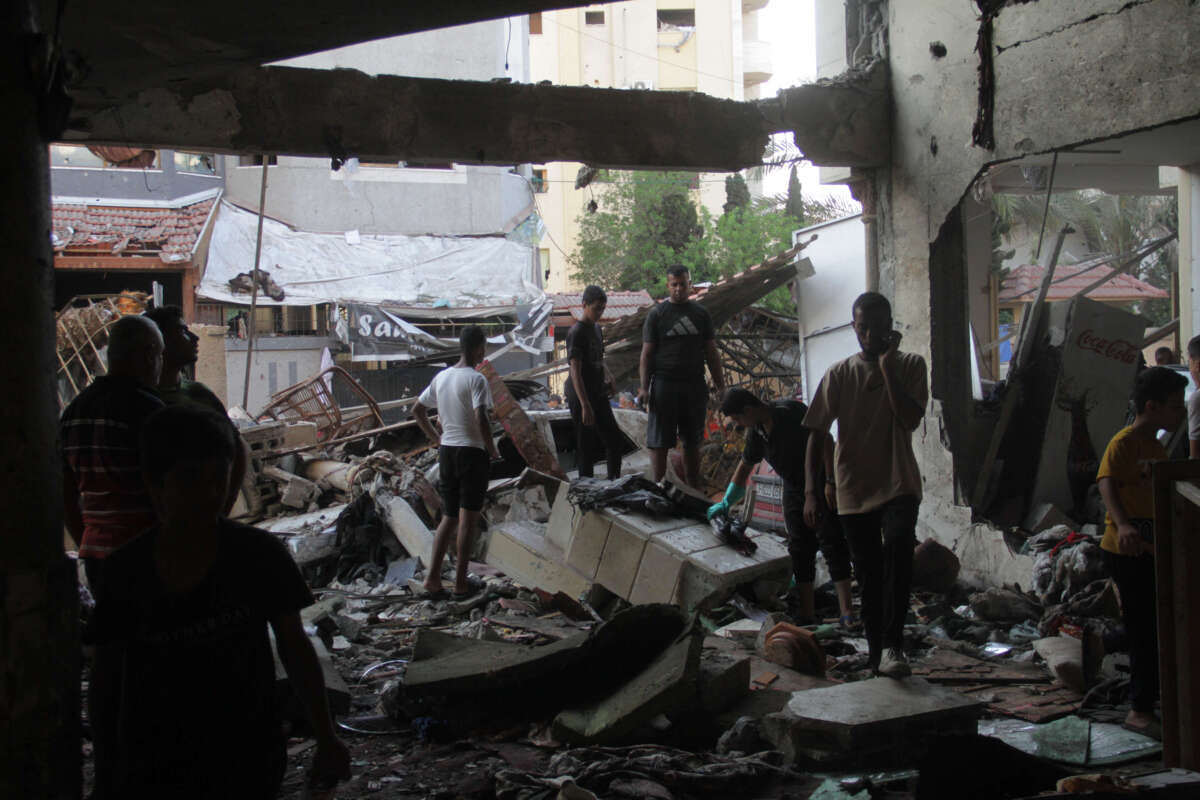Support justice-driven, accurate and transparent news — make a quick donation to Truthout today!
Israeli forces used at least one U.S.-provided bomb in its massacre in a school-turned-shelter that killed nearly 100 Palestinians as they were conducting morning prayers on Saturday, a report finds.
CNN reports that Israel used a GBU-39 small diameter bomb in the strike, citing an analysis by former U.S. army explosive ordnance disposal technician Trevor Ball who was shown footage of fragments of the bomb found at the site.
Israel used three bombs in the strike, possibly including more U.S.-provided bombs; Euro-Med Human Rights Monitor said in a preliminary report that all three bombs were U.S.-made, with “a tremendous capacity to burn, melt, and destroy bodies.”
GBU-39s are 250-pound bombs made by Boeing that Israel has used many times in Gaza throughout its genocide. According to military guides, 250-pound bombs have a 10 percent chance of killing or incapacitating anyone within a 115-foot radius of the impact.
The bombing was one of the deadliest single bombings of Israel’s genocide. Palestinian journalists shared horrific images of the aftermath; Hossam Shabat, a journalist in northern Gaza, shared a picture of several bags of dismembered body parts that survivors picked up after the bombing. Another image of the bombing showed a mass of charred and bloody dismembered people who were killed in the attack.
Because the bomb had shredded the bodies so thoroughly, doctors had to collect body parts in bags and considered every 70 kilograms of body parts to be a person killed. They distributed these bags to families whose family members were missing after the strike, Mondoweiss reported; one man said that all that’s left of his 6-year-old son is a plastic bag with 18 kilograms of human remains given to him by doctors at the hospital.
“I don’t know if this is my son or not, I don’t know what I’m carrying in this bag. They said he’s my son, and I don’t know anything, and I don’t see anything of my son in this bag,” survivor Hassan Ahmad told Mondoweiss.
Gaza officials have said that the al-Tabin school, in Gaza City, was sheltering 6,000 forcibly displaced Palestinians when Israel bombed it. Officials have said that Israel killed 93 in the strike, including at least 11 children, though only 75 bodies have been identified because a large proportion were nearly completely shredded by the attack, rendered unrecognizable.
“When I watched the missile fall, I knew that there would be casualties and that a massacre was going to occur, but I had no idea that my father would be one of them,” Mahmoud Nidal Al-Basyouni, a child, told Euro-Med Monitor of the attack. “I cried for my father, my grandfather, my uncle, and many of the fathers of the children who were targeted during Fajr prayer in the prayer hall and who we were unable to say goodbye to. In the prayer hall, I saw mutilated bodies and bits of flesh.”
The Israeli military said that they were targeting Hamas members in the strike, saying that Hamas forces were using the school as a military base. However, Euro-Med Monitor has said that these claims are patently untrue.
The group’s chair, Ramy Abdu, said that the group reviewed the list of names that Israel claimed were Hamas resistance members who they were targeting and found at least one of these supposed targets is still alive; one is a child under 12 years old who lives in the West Bank; and that most of the others were known to have other civilian jobs with no ties to Hamas forces.
Further, Euro-Med Monitor said that its legal and field team carried out a preliminary investigation of the school-turned-shelter after the attack and found no evidence that the school was used for military objectives. Further, in fact, the school’s layout makes it “impossible” for it to be used for those purposes; rather the school was being used for nothing more than sheltering some of the many who have been forced out of their homes by Israel in its ethnic cleansing campaign.
“As a result, the attack on the school was unjustified and blatantly violated international humanitarian law,” the group wrote.
The White House said in a statement on Saturday that it was “deeply concerned” over reports of the bombing. But that same day, the State Department announced that it was releasing a whopping $3.5 billion to Israel to spend on U.S. weapons and military equipment that had been previously approved by Congress. This comes on top of the $6.5 billion in military assistance that the U.S. has sent Israel since October; and the decades of arms deals leading up to the current genocide that have helped paved the way to this moment.
Press freedom is under attack
As Trump cracks down on political speech, independent media is increasingly necessary.
Truthout produces reporting you won’t see in the mainstream: journalism from the frontlines of global conflict, interviews with grassroots movement leaders, high-quality legal analysis and more.
Our work is possible thanks to reader support. Help Truthout catalyze change and social justice — make a tax-deductible monthly or one-time donation today.
